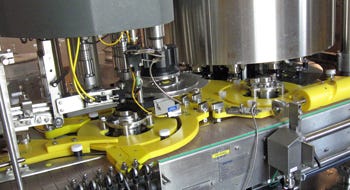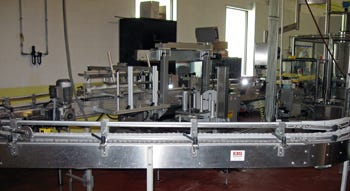
Flavorchem specializes in the creation and manufacture of flavor and color solution
rrrr1 Flavor - .jpg
s for the food, beverage and nutraceutical industries. The company has two locations: Downers Grove, IL and San Clemente, CA.
The company recently installed a new packaging line for flavor components at its sprawling 170,000- sq-ft, eight-building campus in Downers Grove. With the company's product orientation, the line runs a range of product types and viscosities in bottle sizes from 1 oz to 1 gal.
Plus/minus 1 gm accuracy.
Flavor components are inherently expensive, so fill accuracy and minimum waste were major requirements when the line was planned. Flavorchem already had a filler from Serac Inc. that it was very pleased with, so it was an easy decision to install another Serac unit in the new line. Flavorchem installed a Model R12V6/720 monobloc net-weight filler/capper.
Dean Ge
rrrrr2 - Flavorchem .jpg
ndusa, packaging manager, says, "We produce many products (such as multiple folds of vanilla concentrates) that can be very costly, so accuracy and reliability were critical requirements. We already had a Serac filler in another operation, so we were very familiar with it and knew what it could do. Serac is right down the road from us and they give us fantastic service. They trained our mechanics and operators in their facility before we received the new filler, so startup was very smooth. We have never had a problem with them."
He ccontinues, "The Serac is rated at +/- 1 gm accuracy, and it seems to be holding to that figure. It was a tremendous advantage that the Serac could handle the wide viscosity spread of our many products as well as the extreme container spread."
A feedscrew at the inlet of the Serac filler indexes the bottles into a starwheel that, in turn, places the bottles onto the 12 individual platforms of the filler. To achieve the filler's extreme accuracy, each platform incorporates a load cell that weighs the bottle as it enters the machine, then fills product until the weight reaches the set weight of product, at which point the filling valve closes.
In addition to handling the net weight calculations, the computer-based control system on the filler records processing and filling data for every bottle run and provides statistical production feedback. It will present a statistical fill-weight average and standard deviation for any period of production selected, monitor the tare weight of incoming bottles, alert the operator if a bottle is outside of the acceptable weight range, list the number of under-fills and over-fills with the cause of each and monitor run times. It will also reject bottles that do not contain the correct weight of product.
After filling, the bottles are transferred into the integral TCS pneumatic capper. Caps travel down a track from the cap hopper into the capper, where they are picked up by the individual capping heads. To minimize cap damage and provide optimum gripping, th
rrrr3 - Flavorchem .jpg
head is not rotating when it picks up the cap. The capping head starts turning when the cap is engaging the bottle. To further eliminate cap damage, the pressure on the jaws is released and the jaws open as soon as the torque setting is reached.
On this monobloc machine, all operations are controlled by the computer. When changing from one product to another, the operator only has to select the new product from a menu in the computer, and the PC will set the filling and operating parameters automatically.
A sensor on the machine detects bottles with no caps and rejects them
.
Running small bottles
During Packaging Digest's visit, the line was running 1-oz bottles supplied by Olcott Plastics and closures supplied by Berry Plastics. The bottles are received in corrugated cases and are fed into the floor hopper of a bottle
unscrambler/orienter from Pace Packaging Corp. An inclined, cleated conveyor lifts them up to the rotating hopper of the Omni-line M400 unscrambler, w
rrrr4 - Flavor.jpg
hich places the bottles in a lay-flat orientation on a conveyor that carries them past a hook hanging in their path of travel. Bottles, with their bottom ends leading, push the hook up and travel on, but the hook catches the open top of bottles with the top ends leading and flips them over. Thus, all of the bottles have the bottom end leading as they discharge in a standup position on the main conveyor.
The conveyor makes a 180-deg turn and conveys the bottles past a Label-Aire Inc Model 3115-1500 7/12 RH F/6000 pressure-sensitive labeler. This labeler is not used for the 1-oz bottles being run on the line, so it was not operating during PD's visit.
The bottles enter the Serac filler/capper and then travel past an Enercon Industries Corp. Superseal 75 induction sealer that applies a foil membrane across the tops of the bottles.
At this point the conveyor separates with the left leg for quarts and gallons and the right leg for the 1- and 2-oz bottles.
The small bottles bottles are directed onto the right leg by a gate that is positioned by the operator. The bottles enter a Model SK 600 tightening and retorquing machine from SureKap Inc. Parallel belts running simultaneously with the conveyor hold the bottles in place as it is conveyed through the machine and three spindles on each side of the bottles tighten the caps. Gendusa says, "The caps loosen up when they go through the induction unit, so the retorquer ensures that they are tightened to our specifications."
The bottles then t
rrrrr5 - Flavor.jpg
ravel to a Model CSSW001 dual-station pressure-sensitive labeler from Chicago Automated Labeling Inc. that applies top and body labels. A rotating horizontal wheel spaces the bottles as they enter the unit. The web of small round labels containing the customer's name is pulled from a vertical roll and the labels are applied to the tops of the caps. The bottles continue through the machine, which pulls the wrap-around body labels from a horizontal roll in the second station and applies them to the bottles.
The computer-controlled labeler features stepper motors and electronic gearing to provide digital synchronization of the bottle conveyor and roll drives throughout the labeling process, while the machine's PLC handles communications and monitors the entire system to ensure satisfactory operations.
The operator selects the product to be run from a menu on the touch-screen HMI and the PLC sets the operating conditions accordingly.
The labeler includes low and/or broken label detection and will shut down if that occurs.
Bottles are hand packed into cartons, which then have labels applied by a Label-Aire Model 3138-NV printer applicator. Blank labels are supplied on a roll, and the machine prints the product information on the label, and then strips the label from the backing web and applies it to the side of the carton.
The cartons travel past a Model 9020 ink-jet coder from Markem-Imaje that prints product information on the top of the carton.
Quarts and gallons
Filled quart or gallon containers are diverted onto the left leg of the conveyor after the Serac filler and are packed into cases by a Model 300E case packer from Hamrick Manufacturing & Services Inc. Containers enter the machine single file and then converge into two or three lanes depending on the bottle size being run. Empty cases enter on a lower-level conveyor. When the correct number of bottles has accumulated, the empty case is lifted and a plate retracts to allow the bottles to drop into the case. The filled cases exit on a powered conveyor.
Cases are erected on a Model WF-21
rrrr6 - Flavor.jpg
T (tape) machine from Wexxar Packaging Inc. that features Wexxar's pin & dome technology in which the flat case blank is injected into two facing plates, the pins go into the flutes and the dome pinches the corrugated tightly. The two plates then open to 90 degrees to perfectly square the case.
The erector also utilizes Dynamic Flap Folding that eliminates long plow rails and a compliant drive belt system in which each of the two facing unidrive drive belts is mounted on a spring mechanism that allows a constant pressure to be exerted on the case, despite normal variations in case width. Even heavy cases are handled carefully and with great control.
After the cases are filled, their tops are taped shut by a Wexxar Bel 252 automatic case taper, after which the cases are taken to the palletizing operation.
Confab Systems Inc. supplied the conveyors throughout the line.
Richpak Machinery Inc. represents a number of the companies that supplied equipment for this line and assisted in design, installation and startup.
Ed McIntosh, marketing manager at Flavorchem, says, "The new packaging line provides a wide range of packaging options to meet our customer's needs as well as added capacity, improved efficiency, and redundancy for key product lines."
Berry Plastics Corp., 812-424-2904. www.berryplastics. com
Chicago Automated Labeling Inc., 219-531-0646. www.chicagoautolabel.com
Confab Systems Inc., 708-388-4103. www.confabsystems.com
Enercon Industries Corp., 262-255-6070. www.enerconind.com
Hamrick Manufacturing & Services Inc., 800-321-9590. www.hamrickmfg.com
Label-Aire Inc., 714-441-0700. www.label-aire.com
Markem-Imaje, 866-263-4644. www.markem-imaje.com
Olcott Plastics, 630-584-0555. www.olcottplastics.com
Pace Packaging Corp., 973-227-1040. www.pacepkg.com
Richpak Machinery Inc., 312-225-1207.
Serac Inc., 630-510-9343. www.serac-group.com
SureKap Inc., 770-307-4755. www.surekap.com
Wexxar Packaging Inc., 604-930-9300. www.wexxar.com
.
About the Author(s)
You May Also Like


